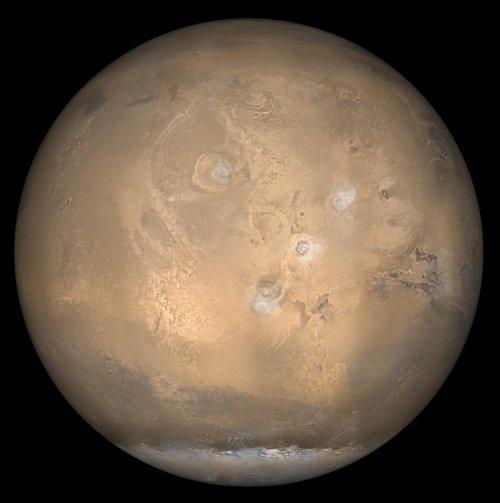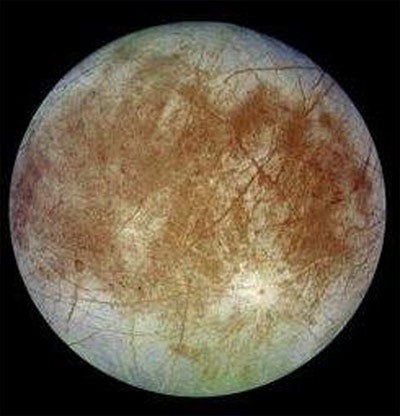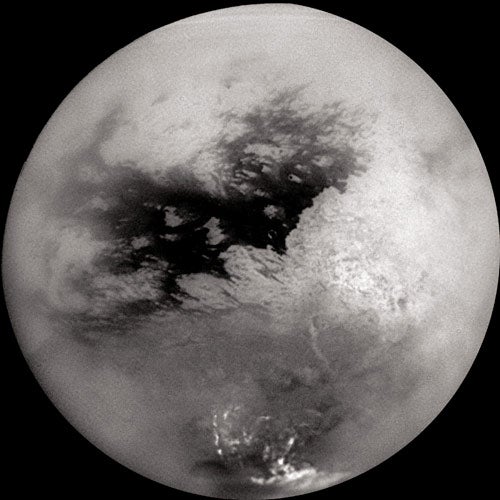There’s perhaps a one-in-20 chance microfossils of living organisms were detected in a meteorite from Mars. This rock, designated ALH84001, crashed in Antarctica’s Alan Hills region some 13,000 years ago. In August 1996, a team led by NASA’s David McKay reported the meteorite contained organic molecules and microfossils.
Mars’ giant volcanoes testify that the planet once had strong geological energy sources. If they’re still operating, they may allow catchments of liquid water to accumulate beneath the surface. The planet’s rust-coated surface shows it has abundant oxidizing agents, as well as plentiful energy available from ultraviolet sunlight.
On the other hand, Mars has no liquid water on the surface today. The atmosphere provides inadequate shielding from radiation. The surface chemistry seems to be strongly oxidizing, which isn’t too good for living cells. Organic compounds have been found only in trace amounts. The planet’s carbon is locked up mostly in carbon dioxide in the atmosphere and polar ice.
Finally, the atmosphere doesn’t appear to be kept out of equilibrium, with reactive gases that require living organisms as a source. One exception: methane detected by Mars Express. Methane in the martian atmosphere oxidizes to form water and carbon dioxide in a few hundred years, so there must be a source. But it’s probably geological rather than biological in nature.
I give the odds of martian life at 1 in 100,000, which is still greater than the chance of winning most lotteries.
Europa’s icy surface provides protection from damaging radiation. Tidal heating may warm the water beneath the surface, possibly creating a vast global ocean. Tidal heating also may create volcanic vents in the deep ocean similar to “black smokers,” which provide food and energy for organisms in terrestrial seas.
On the flip side, that icy crust may be 6 miles (10 kilometers) thick, which would shield the undersea ocean from its best energy source: sunlight. There’s no atmosphere to trap radiation, which makes life at the surface unbearable. And there’s no evident food source.
Jupiter’s moon may have an ace in the hole — a vast subsurface ocean — but the odds of finding life there remain pretty long. I give it 1 chance in 10,000 of developing life.
Saturn’s hazy moon has a thick atmosphere that protects the surface from solar radiation and cosmic rays. Its liquid near-surface environment speeds up chemical reactions. Reduced compounds and compounds with multiple bonds are everywhere. These substances can be converted into more oxidizing compounds with a net gain of energy. In other words, there’s potential food everywhere.
But, the Huygens Descent Imager/Spectral Radiometer saw no evident life. The Gas Chromatograph/Mass Spectrometer revealed a carbon-13 to carbon-12 ratio that isn’t diagnostic of life. The frigid temperature makes necessary chemical reactions hundreds or thousands of times slower than in a warmer place, like Earth, Mars, or Europa. And it isn’t obvious that oxidizers — necessary in biological reactions — are anywhere.
Titan’s disadvantages aren’t as strong as the others, but they’re still strong enough to make life highly unlikely there. Still, I give Titan the best odds — 1 in 1,000 — based on what we now know of all three worlds.
Take a ride on Huygens in this movie from Erich Karkoschka, a member of the Descent Imager Spectral Radiometer (DISR) team at the University of Arizona. Using mosaics of Huygens images mapped onto a Titan-size sphere, the movie replicates the probe’s descent from the altitude where the surface first becomes visible through the haze. To see the video, click on the link below. [Note: This movie is a large file. Depending on your connection, downloading this file may take several minutes.]












